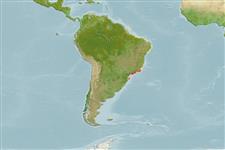Classification / Names
Noms communs | Synonymes | Catalog of Fishes(Genre, Espèce) | ITIS | CoL | WoRMS | Cloffa
>
Blenniiformes (Blennies) >
Labrisomidae (Labrisomids)
Etymology: Paraclinus: Greek, para = the side of + Greek, klinein, kline = sloping and bed, due to the four apophyses of sphenoid bone (Ref. 45335); spectator: From its habit of observing divers and its surroundings.
Environment: milieu / climate zone / depth range / distribution range
Écologie
marin récifal; profondeur 1 - 7 m (Ref. 43114). Tropical
Southwest Atlantic: Brazil.
Taille / Poids / Âge
Maturity: Lm ? range ? - ? cm
Max length : 5.2 cm SL mâle / non sexé; (Ref. 43114)
Épines dorsales (Total) : 27 - 29; Épines anales: 2; Rayons mous anaux: 18 - 20; Vertèbres: 34. Body elongated, mean body depth 21.7% SL in adult males. Wide predorsal area, mean 22.6% SL in adult males. First 2 dorsal fin spines much longer than the rest; distance between 3rd and 4th spine greater than orbit diameter; last dorsal fin element segmented. Opercular spine flattened and triangular (Ref. 43114).
Prefers shallow rocky reefs. Smallest ripe female at 3.7 cm SL (Ref. 43114).
Life cycle and mating behavior
Maturité | Reproduction | Frai | Œufs | Fécondité | Larves
Guimarães, R.Z.P. and A.C.L.H. de Bacellar, 2002. Review of the Brazilian species of Paraclinus (Teleostei: Labrisomidae), with descriptions of two new species and revalidation of Paraclinus rubicundus (Starks). Copeia 2002(2):419-427. (Ref. 43114)
Statut dans la liste rouge de l'IUCN (Ref. 130435: Version 2024-2)
Menace pour l'homme
Harmless
Utilisations par l'homme
Outils
Articles particuliers
Télécharger en XML
Sources Internet
Estimates based on models
Preferred temperature (Ref.
123201): 22.5 - 27.7, mean 26.7 °C (based on 94 cells).
Phylogenetic diversity index (Ref.
82804): PD
50 = 0.5000 [Uniqueness, from 0.5 = low to 2.0 = high].
Bayesian length-weight: a=0.00933 (0.00410 - 0.02122), b=3.10 (2.91 - 3.29), in cm total length, based on LWR estimates for this (Sub)family-body shape (Ref.
93245).
Niveau trophique (Ref.
69278): 3.5 ±0.4 se; based on size and trophs of closest relatives
Fishing Vulnerability (Ref.
59153): Low vulnerability (10 of 100).
